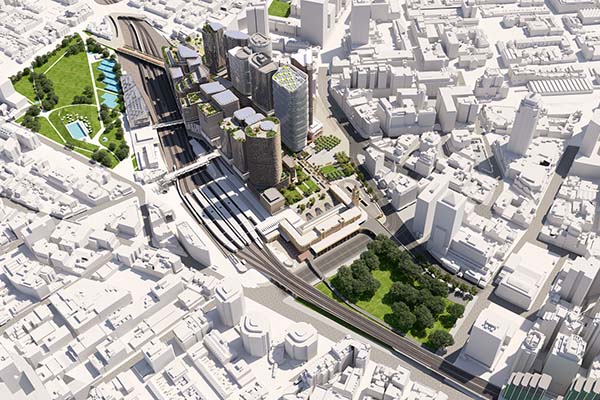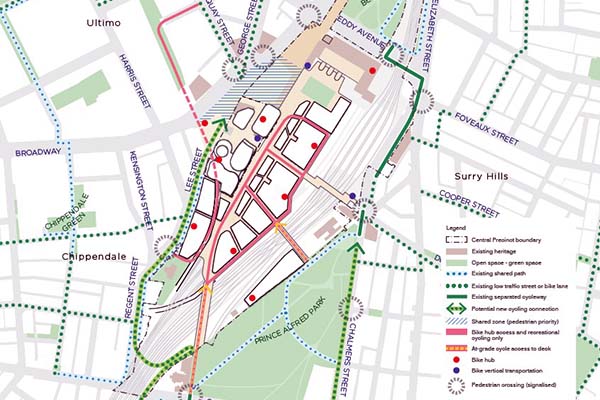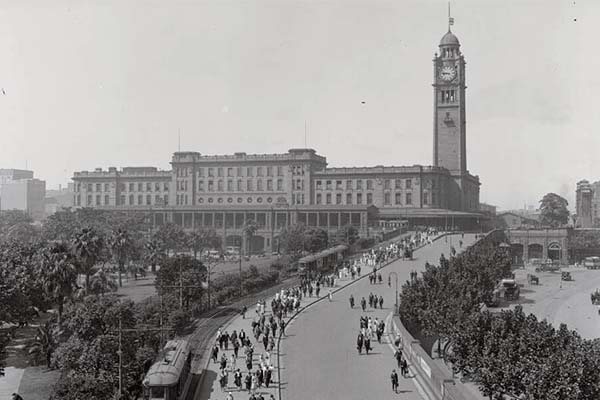Transport for NSW has recently exhibited ambitious plans to transform underutilised land north of Central Station into a mixed-use precinct anchored by a world-class transport interchange and new public spaces.
The redevelopment of the area aligns with the City of Sydney’s long term strategic planning. The railway corridor from Central to Eveleigh has now been earmarked for ‘innovation’ industries and re-branded as Tech Central. Construction of Atlassian’s innovative timber tower is already underway.
Bicycle NSW took a deep dive into the 5750 pages of reports and strategies to understand what is promised for walking and cycling at the future Central Precinct. Our submission is here.
New connectivity
The railyards have carved a large void in the urban landscape. They form a physical barrier to movement in all directions. The proposal to build over the regional track behind the heritage terminal building offers exciting opportunities to repair missing links in the walking and cycling networks. Three new bridges will cross the suburban rail tracks to connect to the surrounding urban fabric.
Another brilliant new link will be delivered by extending the Goods Line from Ultimo to the historic Mortuary Station. The abandoned sandstone railway tunnel lies underneath Central Station and was originally used to transport goods from Darling Harbour.

Central Precinct viewed from the east, showing the buildings that will sit on the over-station deck and 3 the new bridges crossing the rail corridor: at Cleveland St, Prince Alfred Park and Devonshire St (Source: TfNSW/Arcadis)
The five key strategic ‘moves’ that inform the conceptual planning stress the importance of new north-south and east-west links across the precinct. The Urban Design Framework promises a permeable network of clear cycling routes through the precinct.

The Five Big Moves from the Central Precinct Place Strategy clearly show the importance of new connections across the site (Source: TfNSW)
There is much to be enthusiastic about! However, we have found many flaws in the current plans. Much more work is needed to resolve technical and topographical constraints if the Central Precinct redevelopment is to deliver useful connections for bike riders.
The issues for active transport
The detailed bike network plan shows convoluted and indirect routes that do not traverse the precinct and meet dead ends. Ramped cycle access is only indicated at George Street bridge and Prince Alfred Park bridge. In all other locations, vertical transport to the over station development (OSD) will be in the form of lifts, escalators and stairs.
Bike riders will need to dismount to use lifts. This is extremely inconvenient, particularly for those with disabilities, and weakens an essential component of the master plan.
The critical east-west connection at Devonshire Street bridge requires a lift, as does any access from the west and north. There appears to be no way for bikes to enter the northern part of the precinct. The cycle routes do not go near the train platforms to provide easy access to trains. Cyclists wishing to connect to the new Goods Line link must use a lift.

Extract from the Urban Design Framework showing the proposed cycling network (Source: TfNSW)
It is clear that level changes are a major challenge, but it is incredibly disappointing to abandon the ambition to create rideable links through Central Precinct at such an early stage in the development process.
Another concern is that access for bicycles to the heart of the precinct is downplayed at several points in the technical reports. Within the precinct, only recreational cycling or access to the bike parking hubs will be permitted. Even the Goods Line extension, the precinct’s much-trumpeted offering for active transport, is slated to be for recreational cycling and access only!
Finally, the Railway Colonnade ramp from Hay Street to the Western Forecourt does not feature in any active transport plans. This ramp will be retained and has heritage value, but it is flagged for use by taxis, coaches and emergency vehicles only. The ramp is very wide and has plenty of space for bicycles as well – as the old photo shows it has long been a critical connection that negotiates the level change between the street and the train platforms.

The Railway Colonnade ramp has always provided important pedestrian and bicycle access to the train platforms (Source: TfNSW)
Bicycle NSW is very excited by the potential for the redevelopment to deliver game-changing upgrades to the active transport network. The masterplan attempts to address the barriers to cycling to and through Central Station but, as discussed, the proposals are flawed and inconsistent. We have made a very long list of recommendations in our submission. We will continue to push Transport for NSW to prioritise fantastic active transport links as Central Precinct evolves over the months, years and decades ahead!
Please support our advocacy work on active transport infrastructure, both in Sydney and across NSW, by joining the Bicycle NSW family today.

